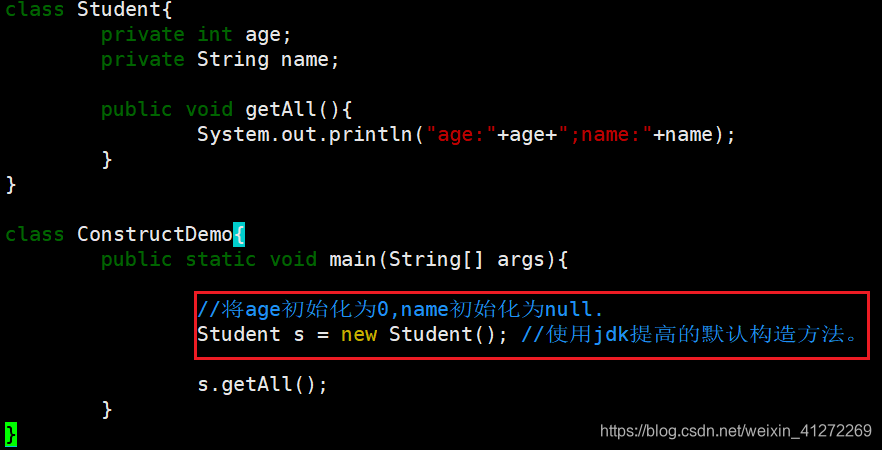- 构造方法的及其特点:
构造方法是为了给对象的数据进行初始化。
1. 方法名与类名相同
2. 没有返回值类型。 //连void也没有。
3. 没有具体的返回值。
我们一直在使用构造方法,但是,我们确没有定义构造方法。
A:如果我们没有给出构造方法,系统将自动提供一个无参构造方法。
B:如果我们给出了构造方法,系统将不再提供默认的无参构造方法。
注意:这个时候,如果我们还想使用无参构造方法,就必须自己给出。
建议永远自己给出无参构造方法
- 给成员变量赋值有两种方式:
A:setXxx()
B:构造方法
- jdk提供的默认构造方法

- 自己给出无参构造方法

- 自己给出有参构造方法

- 多个构造方法并存

- 代码解释
class Student {
private String name; //null
private int age; //0
public Student() {
System.out.println("这是无参构造方法");
//构造方法在类创建对象的时候运行,用来给对象的数据进行初始化。
}
}
class ConstructDemo {
public static void main(String[] args) {
Student s = new Student(); //带括号的都是方法,Student()是无参构造方法。
//创建了一个对象s,并且这个同时运行了构造方法。
System.out.println(s); //Student@e5bbd6
}
}
class Student {
private String name;
private int age;
public Student() {
//System.out.println("我给了,你还给不");
System.out.println("这是无参构造方法");
}
//构造方法的重载格式
public Student(String name) {
System.out.println("这是带一个String类型的构造方法");
this.name = name;
}
public Student(int age) {
System.out.println("这是带一个int类型的构造方法");
this.age = age;
}
public Student(String name,int age) {
System.out.println("这是一个带多个参数的构造方法");
this.name = name;
this.age = age;
}
public void show() {
System.out.println(name+"---"+age);
}
}
class ConstructDemo2 {
public static void main(String[] args) {
//创建对象
Student s = new Student();
s.show();
System.out.println("-------------");
//创建对象2
Student s2 = new Student("林青霞");
s2.show();
System.out.println("-------------");
//创建对象3
Student s3 = new Student(27);
s3.show();
System.out.println("-------------");
//创建对象4
Student s4 = new Student("林青霞",27);
s4.show();
}
}
